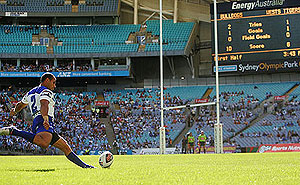RUGBY LEAGUE 101
The objective of the game is to outscore you opponents - this can be achieved by either scoring a "try" (think touchdowns), penalty goals, or field goals.
SCORING AND BASIC INFORMATION
A try is a scored when a player grounds the ball in their opposition's goal, the important thing is the ball must touch the ground while the player still has control over the ball. After a successful try is awarded, a conversion kick is given (think extra point) This kick is taken parallel to where the try was scored and 20 back from the goal line. The ball must then be kicked through the goal posts for the points to be awarded.
Penalty's are awarded to a team when the opposition makes an illegal play - the team awarded the penalty can then choose to attempt a penalty goal for further points, or kick the ball down field and gain the territory.
Field Goals are "drop kicks" that must go through the goal posts for points to be awarded. These are difficult to achieve and are generally only attempted when the game is very close and toward the end of the match.
So, points can be scored through;
 |
| A Try - 4 points |
 |
| A conversion or penalty kick - 2 points |
 |
| A Field Goal - 1 point |
The game is played on a 100m x 68-70m field with goal posts on the centre of each "goal line" very simliar to gridiron. The lines are marked at 10 metre intervals as is show in the below image.
 |
| Rugby League Field |
Teams consist of 17 players, with 13 on the field at any one time. The other 4 players make up the interchange bench - 10 interchanges are allowed per game. The games themselves last 80 minutes, and are split in into two 40 minute halves.
PLAYING POSITIONS
Backs
Fullback - The name comes from their defensive position where the player drops out of the defensive line to cover the rear from kicks and runners breaking the line. In attack the fullback will typically make runs into the attack or support a runner in anticipation of a pass out of the tackle.
Wing - These players (2 per team) are normally the fastest players in a team and play on the far left and right fringes of the field. Their main task is to receive passes and score tries. The wingers also drop back on the last tackle to cover the left and right sides of the field for kicks while the fullback covers the middle.
Centre - These players (2 per team) are positioned one in from the wings and usually have a good mixture of power and vision. Their main role is to try to create attacking opportunities for their team and defend against those of the opposition.
Five-Eighth and Half Back - These two players are the main play makers on the team, meaning that they generally have the best vision and ball handling skills in the team. Traditionally the half back would run plays with the forwards while the five-eighth would organise the back - however this line has blurred in the modern game.
Forwards
Prop - These players (2 per team) are generally the largest and strongest players on field. They are positioned in the centre of the defensive line and act as an "enforcer" in defence. In attack it is their role to give the team momentum by taking the ball up to the defence aggressively.
Hooker - The hooker will be responsible for organising the defence in the middle of the field. In attack as dummy-half this player is responsible for starting the play from every play-the-ball by either passing the ball or running from dummy-half. Due to this hooker's should have the ability to pass the ball with great skill.
Second Row - The modern day second row is very similar to a centre and is expected to be faster, more mobile and have more skills than the prop. Providing strength in attack and defence, good second-rowers combine the skills and responsibilities of props and centres in the course of the game. There are two of these per team.
Lock - Locks are usually among the fittest players on the field, covering the entire field on both attacking and defending duties. Typically they are big ball-runners who can occasionally slot in as a passing link or kick option - often these players can play a simliar role to that of the five-eighth.
Cool post. I've been getting into rugby, although I think it's Union, and sometimes I don't understand what's going on.
ReplyDeletewow very informative i've never known how to play so i appreciate this
ReplyDeletecool post, used to play a little rugby myself
ReplyDeletegood info :)
ReplyDelete